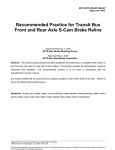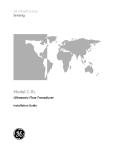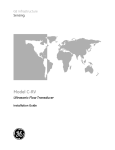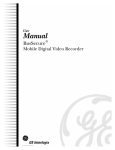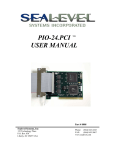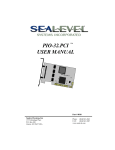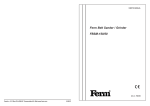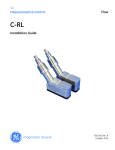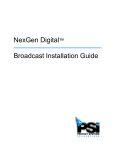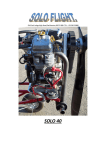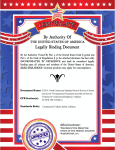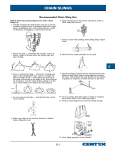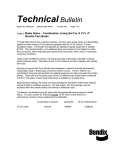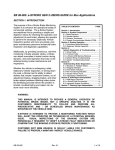Download Transit Bus S-Cam Brake Reline - American Public Transportation
Transcript
APTA STANDARDS DEVELOPMENT PROGRAM RECOMMENDED PRACTICE American Public Transportation Association 1666 K Street, NW, Washington, DC, 20006-1215 APTA BT-RP-009-07 Rev 1 WG Vote February 26, 2014 Bus Brake & Chassis Working Group Transit Bus S-Cam Brake Reline Abstract: This Recommended Practice provides guidelines for performing a complete brake reline on the front and rear axle of a bus with S-cam brakes. The practice includes the disassembly, cleaning, inspection and assembly. This document is to be used in conjunction with the manufacturer’s service manual. It is recommended that all components be replaced equally on both wheel ends of the axle. Failure to do so may affect braking performance. Keywords: anchor pins, brake adjuster, brake maintenance, brake rebuild, brake reline, brake shoe rollers, brake shoes, return spring, S-cam bushings, spider, wheel bearings, wheel seals Summary: This document establishes a recommended practice for transit bus front/rear axle S-cam brake reline. Individual operating agencies should modify these guidelines to accommodate their specific equipment and mode of operation. The following recommended practices and guidelines assume that the end users have sufficient skills and knowledge to repair and maintain the related systems at a journeyman level. These skills and knowledge must also include a fluent understanding of safe shop working practices, not only for the agency but also OSHA/CCOHS/provincial/federal/state and local safety standards. A familiarity with applicable industries, component/system suppliers, and vehicle manufacturers is also assumed. Scope and purpose: This Recommended Practice provides guidelines for disassembly, preparation, inspection and reassembly of typical heavy-duty transit bus S-cam brakes. The components may be different than pictured, and some procedures will vary. The purpose of this document is to provide a uniform standard for heavy-duty transit bus brake reline. This Recommended Practice represents a common viewpoint of those parties concerned with its provisions, namely, transit operating/planning agencies, manufacturers, consultants, engineers and general interest groups. The application of any standards, practices or guidelines contained herein is voluntary. In some cases, federal and/or state regulations govern portions of a transit system’s operations. In those cases, the government regulations take precedence over this standard. APTA recognizes that for certain applications, the standards or practices, as implemented by individual transit agencies, may be either more or less restrictive than those given in this document. © 2014 American Public Transportation Association. Contents Introduction ............................................................................................ iii 1. Hazardous material warning ............................................................. 1 Participants The American Public Transportation Association greatly appreciates the contributions of xx, who provided the primary effort in the drafting of this Recommended Practice. At the time this standard was completed, the working group included the following members: xx, Chair xx, Vice Chair xx xx 2. Preliminary inspection ....................................................................... 1 2.1 Vehicle brake and maintenance history ....................................... 1 2.2 Overall performance-based brake test ......................................... 2 2.3 Visual inspection ......................................................................... 2 2.4 Automatic brake adjuster maintenance, inspection and testing ... 4 3. Removal of wheels, hubs and drums ............................................... 4 3.1 Front wheels, hubs and drums ..................................................... 4 3.2 Rear wheels, hub and drum.......................................................... 5 4. Foundation brake disassembly......................................................... 9 4.1 Inspect brake shoes before removal ............................................. 9 4.2 Disassemble the foundation brake ............................................... 9 4.3 Removal of the brake shoes ......................................................... 9 4.4 Remove the brake adjuster, S-cam and bushings......................... 9 5. Cleaning and inspection .................................................................. 11 5.1 Spider, spindle and axle tube ..................................................... 11 5.2 Checking the spider alignment .................................................. 11 5.3 S-cam inspection ........................................................................ 12 5.4 Springs and rollers ..................................................................... 12 5.5 Brake shoes ................................................................................ 13 5.6 Wheel bearing inspection .......................................................... 13 5.7 Drum .......................................................................................... 13 5.8 Machining drums lining ............................................................. 13 5.9 Hub/ABS tone ring .................................................................... 13 6. Assembling the foundation brake .................................................. 13 6.1 Install S-cam bushings ............................................................... 13 6.2 Install S-cam seals ..................................................................... 14 6.3 Install anchor pin bushing .......................................................... 15 6.4 Install S-cam .............................................................................. 15 6.5 Install brake adjusters ................................................................ 15 6.6 Install brake shoes...................................................................... 16 6.7 Install front wheel bearings, seals and hub assembly ................ 18 6.8 Install rear wheel bearings, seals and hub assembly .................. 19 6.9 Brake adjustment ....................................................................... 22 7. Burnishing, testing and final inspection ........................................ 22 7.1 Burnishing.................................................................................. 22 7.2 Performance test ........................................................................ 23 7.3 Final inspection.......................................................................... 23 Appendixes ........................................................................................... 24 References ............................................................................................ 38 Definitions ............................................................................................. 38 Abbreviations and acronyms .............................................................. 39 © 2014 American Public Transportation Association | ii Introduction This Recommended Practice reflects the consensus of the APTA Bus Standards Program members on the items, methods and procedures that have provided the best performance record based on the experiences of those present and participating in meetings of the program task forces and working groups. Recommended Practices are voluntary, industry-developed and consensus-based practices that assist equipment suppliers, vehicle and component manufacturers, and maintenance personnel in the construction, assembly, operation and maintenance of transit bus vehicles. Recommended Practices may include test methodologies and informational documents. Recommended Practices are non-exclusive and voluntary; they are intended to neither endorse nor discourage the use of any product or procedure. All areas and items included herein are subject to original equipment manufacturers’ supplemental or superseding recommendations. This document is recommended for: individuals or organizations that inspect and maintain transit buses; individuals or organizations that contract with others for the inspection and maintenance of transit buses; and individuals or organizations that influence how transit buses are inspected and maintained. © 2014 American Public Transportation Association | iii APTA BT-RP-009-07 Rev 1 | Transit Bus S-Cam Brake Reline Transit Bus S-Cam Brake Reline 1. Hazardous material warning Take all necessary precautions prescribed by federal, provincial/state and local safety requirements. Refer to the components’ material safety data sheets (MSDS) for all necessary precautions. Follow the general safety procedures listed below when working with braking components: Whenever possible, work on brakes in a separate area away from other operations. Always wear a respirator approved by the National Institute for Occupational Safety and Health (NIOSH) or the Mine Safety and Health Administration (MSHA) during all brake service procedures. Avoid creating dust. Never use compressed air or dry brushing to clean brake parts or assemblies. The Occupational Safety and Health Administration (OSHA) recommends that you use cylinders that enclose the brake. The cylinders have vacuums with high-efficiency particulate absorption (HEPA) filters and arm sleeves. If such equipment is not available, then carefully clean parts and assemblies in the open air. During disassembly, carefully place all parts on the floor or in a suitable cleaning station to avoid getting dust into the air. After vacuum cleaning, any remaining dust should be removed using a rag soaked in water and then wrung until nearly dry. If it is necessary to grind or machine brake linings, then additional precautions should be taken because contact with fiber dust is higher during these operations. In addition to wearing an approved respirator, such work should be done in an area with exhaust ventilation. Never use compressed air or dry sweeping to clean the work area. Use an industrial vacuum with HEPA filters and rags soaked in water and wrung until nearly dry. Used rags should be disposed of with care to avoid getting dust into the air. Use an approved respirator when emptying vacuum cleaners and handling used rags. Wash hands before eating, drinking or smoking. Work clothes should not be worn home, but should be vacuumed after use and then laundered separately, without shaking, to prevent dust from getting into the air. 2. Preliminary inspection In cases where components such as brake adjusters, brake chambers and camshafts are not scheduled for replacement during the reline, each property should establish a schedule for replacing these components based on the local operating conditions and usage history. 2.1 Vehicle brake and maintenance history This Recommended Practice also applies to components of the system that do not have wear indications. To determine a proactive replacement schedule, use the manufacturers’ recommendations for component replacement/rebuild and/or the agency’s component history. These may be based on mileage, brake cycles or time. They may include variables such as climatic considerations, unique operating parameters or a combination of both. The replacement schedules will vary from agency to agency. Any historical data must be accurate, updated as required and meet the challenge of consistent performance, reliability and repeatability. Agencies that have the expertise of data collection, evaluation and mechanical © 2014 American Public Transportation Association 1 APTA BT-RP-009-07 Rev 1 | Transit Bus S-Cam Brake Reline knowledge can use this historical data to schedule brake system component replacement/rebuild intervals. If historical data is unavailable, then a program of data collection should be implemented for future needs. Appendix C illustrates an example of a form used to collect such data. 2.2 Overall performance-based brake test A performance-based brake test (PBBT) can be used as part of the inspection process to assess the efficiency of the brake system and its assemblies prior to scheduled repairs. A test can measure the operator input (application control line air pressure) and the brake output (delivered brake force through the wheels). An individual brake assembly or axle may lose its effectiveness and not be detected before the brake block is worn to the normal replacement level. An ineffective brake can cause side-to-side or axle-to-axle imbalances of the total brake system. When identified, an ineffective brake assembly can be repaired or replaced in addition to the already scheduled repairs. A detailed explanation of how a PBBT can help technicians identify braking defects can be found in APTA-BTS-BC-001-005. 2.2.1 Retarder operation Service brakes are designed to stop a vehicle in a safe and controlled manner; however, for enhanced drivability and extended brake life, some buses are equipped with supplemental braking systems. Apparent brake problems could be associated with these supplemental brakes. Because of the many different applications (transmission retarder, engine brake, driveline retarder, regenerative braking) and configurations (auto apply, electronic controlled, air controlled), consult the (original equipment manufacturer) OEM manual for proper testing procedures. NOTE: Supplemental braking may lead to surface area glazing of the brake drum and lining. 2.3 Visual inspection Removal of wheels or other components will prevent the inspection of selected brake components. Prior to the disassembly of the foundation brake and related wheel/brake components, thoroughly inspect the foundation brake system, which includes the automatic brake adjuster, brake block, drums, brake chambers, mounting fasteners and other system parts. Safely raise and support the bus by the axles at an appropriate working height. 2.3.1 Confirm need for reline in accordance with agency policies and procedures Validate that the reline is necessary by using one or more of the following criteria: agency policies and procedures Commercial Vehicle Safety Alliance (CVSA) North American Standard Out-of-Service Criteria criteria listed within this document 2.3.2 Visually inspect the brake block Check for wear: Block should not be worn to the wear line (if equipped) or less than ¼ in. (for ¼ in. bolt) and ⅜ in. (for ⅜ in. bolt) as measured at the center of the shoe. At no time should rivets or bolts touch the drum. Check for movement: There should be no movement between the brake block and the shoe. Look for cracks: No cracks should have a void greater than 1/16 in. or longer than 1½ in. Check for missing segments or linings that expose a fastener. Inspect for signs of block contamination — e.g., oil or grease. © 2014 American Public Transportation Association 2 APTA BT-RP-009-07 Rev 1 | Transit Bus S-Cam Brake Reline 2.3.3 Confirm components applications The braking system is designed to provide safe and balanced braking. Make sure all components are of the same dimensions and specifications as recommended by the OEM (proper length brake adjusters, proper brake chamber size, etc.). 2.3.4 Dragging/tight wheels With all four wheels elevated off the ground, rotate each wheel to check for dragging or tight brakes. 2.3.5 Pushrod travel Measure pushrod travel at each brake per CVSA North American Standard Out-of-Service Criteria Part II, 1.a (4). CVSA specifications for stroke adjustment limits can be found in Table 1 and Table 2 in Section 7.3 of this document. Pushrod travel should be within ¼ in. measurement from left to right wheel on the same axle. Excessive pushrod travel may be cause to replace the brake adjuster or other foundation brake parts as required to meet new or original specification. During pushrod travel measurements, check S-cam for excessive movement and that the foundation brakes return to normal, without binding or sticking, when the brakes are released. 2.3.6 Brake chamber During pushrod travel measurements, listen for air leaks in the brake chambers or other air system components. Additional or extended application of the brake system may be needed to meet U.S. Department of Transportation (DOT) standards for air system leak tests. Inspect for damage (dents, corrosion, rust, etc.), bent or cracked brackets, bent push rods, air leaks, and missing dust caps. 2.3.7 Hardware Check the condition of the clevis, pin and yoke. Check the integrity of the return springs. Check for damaged/worn drums. 2.3.8 Lining wear/cam position The position of the roller on the cam should be closely checked at every brake inspection. The position of the roller on the S-cam is directly related to brake block and drum wear. Other factors, such as stretched shoes and worn cam bushings, may also affect cam-to-roller position. Care must be taken when inspecting the brakes to ensure that the roller on the S-cam will not lock or allow the S-cam to “cam over” before the block wears out. 2.3.9 Air hoses Inspect for cracks, kinks, routing, leaking, chafing, deterioration, proper size and material. 2.3.10 Visual Inspection of suspension/steering components Some braking complaints can be caused by steering and/or suspension problems. Worn, damaged or misaligned steering/suspension components can cause a vehicle to pull or drift during braking. Carefully inspect the torque rod bushings, drag links, tie-rod ends, king-pins and shock absorbers as part of every prereline inspection. In many cases it’s more efficient to replace/repair these parts during the reline because the wheel assemblies are removed. © 2014 American Public Transportation Association 3 APTA BT-RP-009-07 Rev 1 | Transit Bus S-Cam Brake Reline 2.4 Automatic brake adjuster maintenance, inspection and testing Clean and inspect the automatic brake adjuster per manufacturer’s recommendation or replace as needed. CAUTION: Do not submerge brake adjusters in solvent, water or hot tank. All automatic brake adjusters require inspection at periodic intervals. This should be done at the agency’s normal preventative maintenance inspection as per manufacturer’s recommendation. At these times, the following tests/checks should be performed: Measure and record the brake chamber pushrod travel with reservoir pressure between 90 and 100 psi and brakes fully applied. Check drum to shoe clearance. Grease each brake adjuster. Inspect each brake adjuster for integrity and connection points at the clevis and brackets, if used. Check for a difference in the stroke length between the left and right sides of the axle. There should be no more than ¼ in. difference. If the stroke exceeds the CVSA or DOT maximum allowances, then do not manually adjust the automatic brake adjuster. Follow the manufacturer’s procedure to determine the cause of the excessive stroke. NOTE: Some brake adjusters use special grease, while others use normal chassis grease. It is important to use the proper grade of grease per manufacturer’s recommendation. NOTE: Not all automatic brake adjusters require the same maintenance procedures. Be sure to follow the specifications of the manufacturer. 3. Removal of wheels, hubs and drums 3.1 Front wheels, hubs and drums The procedure that follows describes removing the wheels, hubs and drums as an assembly. However, based on the availability of lifting fixtures, brake styles or an agency’s policy, the wheels, drums and hubs may be removed separately. Back off the brake adjuster until there is enough clearance between the shoes and drum to allow the drum to be removed. CAUTION: Do not use impact wrench on the brake adjuster. NOTE: The procedure used to back off the brake adjuster will depend on the type of brake adjuster used. Check with the manufacturer for a detailed procedure. Check the hubcap for leaks or damage. If the bus uses oil-lubricated bearings, then drain the oil into an appropriate container and dispose of the oil in accordance with local regulations or agency policy. Remove the cap screws from the hubcap. Remove the hubcap and discard if damaged. Remove and discard the gasket. Remove the bearing retaining nuts. This procedure varies between manufacturers and applications (lock washers, pinch bolt, lock rings, etc.). Refer to OEM guidelines for specifics. © 2014 American Public Transportation Association 4 APTA BT-RP-009-07 Rev 1 | Transit Bus S-Cam Brake Reline FIGURE 1 FIGURE 2 Removing Locking Mechanism Removing Outer Bearing CAUTION: Always use the proper size socket when tightening or loosening the lock nuts. Do not use a hammer and chisel to loosen and remove the nuts. NOTE: The procedure above is typical of an adjusting nut, lock mechanism and lock nut arrangement. There are also single nut adjusting and locking arrangements. If necessary, consult the maintenance manual for the correct procedures and tools. NOTE: Proper bearing maintenance must be maintained to ensure safe and reliable bearing performance. Remove the outer wheel-bearing cone. Keep the bearing cup and cone as a matched set. Replace bearing cups and cones as an assembly. If bearing is dropped, the cup and cone must be replaced. Do not “spin dry” the bearing with compressed air. Use a wheel dolly to remove the wheel, drum and hub as an assembly. Remove the front inner wheel seal and wheel bearing. Discard the seal. CAUTION: Use a seal removal tool that does not put pressure on the bearing or damage the hub seal bore. Wipe all excess grease or oil from the spindle. 3.2 Rear wheels, hub and drum Attach shop air to the bus and release the parking brake. Ensure that the spring brake (parking brake) is fully released. If the spring brake is not releasing or will not stay released, then the brake will need to be caged or the chamber replaced. Loosen the brake adjuster until there is enough clearance between the shoes and drum to allow the drum to be slid over the shoes and removed. CAUTION: Do not use impact wrench on brake adjuster. © 2014 American Public Transportation Association 5 APTA BT-RP-009-07 Rev 1 | Transit Bus S-Cam Brake Reline FIGURE 3 Wheel, Hub and Drum Removal NOTE: The procedure used to back off the brake adjuster will depend on the type of brake adjuster used. Check with the manufacturer for a detailed procedure. 3.2.1 Single-reduction axle Loosen the axle nuts. There are multiple methods for breaking the axle loose: • Use jack screws. • Cover the raised boss on the center of the axle flange and strike with hammer (Figure 4). After breaking the axle loose, remove the nuts, washers and alignment dowels. Remove the axle shaft from the housing (Figure 5). FIGURE 4 FIGURE 5 Loosening the Axle Removing the Axle NOTE: The streetside and curbside shafts may differ. Make sure they get reinstalled on the same side as they were removed from. Remove and discard any seals and gaskets. Remove the lock nut, lock washer and pierced locking ring. Remove the outer bearing cone from the wheel hub. CAUTION: Always use the proper size socket when tightening or loosening the lock nuts. Do not use a hammer and chisel to loosen and remove the nut. © 2014 American Public Transportation Association 6 APTA BT-RP-009-07 Rev 1 | Transit Bus S-Cam Brake Reline FIGURE 6 Removing Outer Nut and Bearing NOTE: The procedure described above is typical of an adjusting nut, locking mechanism, and lock nut arrangement. There are also single-nut adjusting and locking arrangements. If necessary, consult the OEM maintenance manual for the correct procedures and tools. NOTE: Proper bearing maintenance must be performed to assure safe and reliable bearing performance. Keep the bearing cup and cone as a matched set. Replace bearing cups and cones as an assembly. If bearing is dropped, then the cup and cone must be replaced. Do not “spin dry” the bearing with compressed air. Place a wheel dolly under the dual rear wheel. Use the wheel dolly to carry the weight of the rear wheels. Remove the wheels, drum and hub as an assembly. If the inside wheel seal uses an oil seal wiper sleeve, remove it by heating one side of the sleeve. Then while holding a hammer on the opposite side of the heated surface, strike the heated area with a hammer to loosen it (Figure 8). Taking care not to hit the axle tube, use a punch or chisel to drive the oil wiper sleeve off the housing; then discard. FIGURE 7 FIGURE 8 Removing Rear Wheel Assembly Removing the Wiper Sleeve NOTE: Do not overheat the wiper sleeve. Use only enough heat to aid in the distortion of the sleeve. © 2014 American Public Transportation Association 7 APTA BT-RP-009-07 Rev 1 | Transit Bus S-Cam Brake Reline If the bus is equipped with a wiper sleeve and outboard wheel seal, then use a punch to remove the oil seal wiper and cork assembly; then discard. To replace inner wheel seal, remove the screws attaching the inner seal retainer to the hub. Remove the inner seal retainer assembly and gasket, along with the inner wheel-bearing cone. Discard the gasket. Using a soft punch, drive the seal from the retainer, taking care not to damage the sealing surface of the retainer. Thoroughly clean all grease from the wheel and hub. FIGURE 6 Removing Inner Seal and Bearing 3.2.2 Double-reduction drive axle It is not necessary to remove the axles or to disassemble the planetary assembly to remove the drums on a double-reduction drive axle (Figure 10): Remove the lug nuts. Remove the rear wheels. Remove the drum. FIGURE 10 Double Reduction NOTE: Though not necessary to disassemble the planetary assembly to perform a rear axle reline, it will be necessary when replacing the S-cams and/or S-cam bushings or bearings. © 2014 American Public Transportation Association 8 APTA BT-RP-009-07 Rev 1 | Transit Bus S-Cam Brake Reline 4. Foundation brake disassembly 4.1 Inspect brake shoes before removal The way the brake block has worn can help determine the condition of the foundation brake. Look for unusual patterns, such as the angle of wear, uneven lining wear and the condition of the brake block. See Appendix D for examples of abnormal brake block wear and the likely cause. When disassembling the brakes for reline, note the condition of each brake component before disposing. 4.2 Disassemble the foundation brake On steer axles, turn the spindle to the fully locked position to gain access to the anchor pin locks. 4.2.1 Remove the brake shoes If present, remove backing plates (dust covers). Remove the anchor pins on non-fixed anchor pin styles of brake (Figure 11). Remove the anchor pin locking fasteners (bolts, snap ring, anchor pin bracket). Use a soft drift and drive the anchor pins out. FIGURE 11 FIGURE 12 Removing Anchor Pin Lock Removing Return Springs NOTE: Anchor pins may be difficult to remove. Take care to avoid bending the spider when removing the anchor pins. Frozen anchor pins should always be removed with a press. NOTE: Anchor pins must be replaced as part of every brake reline. 4.3 Removal of the brake shoes NOTE: Care must be taken not to damage the antilock braking system (ABS) sensors or wear sensor wiring when removing the shoes. With the anchor pins removed, use a suitable tool to remove the return springs (Figure 12). Take care not to drop the shoe assemblies when removing the return springs. Remove the brake shoes from the spider and discard the return spring(s). 4.4 Remove the brake adjuster, S-cam and bushings On steer axles, turn the spindle to the fully locked position to gain access to the anchor pin locks. Clean any buildup of dirt and grease from the end of the S-cam and brake adjuster. © 2014 American Public Transportation Association 9 APTA BT-RP-009-07 Rev 1 | Transit Bus S-Cam Brake Reline 4.4.1 Remove the brake adjuster Remove and discard cotter pin. Remove clevis pin and inspect for wear. Replace as necessary. Inspect the yoke and brake adjuster bushing for wear. Replace parts as necessary. Remove the snap-ring or retaining bolt and washer from the end of the S-cam (Figure 13). FIGURE 13 FIGURE 14 Removing Snap Ring Removing S-Cam If equipped, disconnect the brake adjuster control arm bracket. Remove the brake adjuster and the spacing washers. Inspect all parts and replace as necessary. 4.4.2 Remove S-cam and bushings Once the brake adjuster and brake shoes have been removed, the S-cam can be slid out toward the outside of the bus (Figure 14). NOTE: It will be necessary to remove the planetary and wheel hub assemblies on the double-reduction drive axle in order to remove the S-cam. Remove and discard S-cam bushings at every reline. S-cam bushings keep the S-cam and brake shoe assemblies centered in the brake drum. As the bushings wear, they allow the S-cam to fall off center, creating unequal drum clearance between the top and bottom shoes. This can affect pushrod travel, braking torque and braking performance. To remove the bushings, use a tool specifically designed for bushing removal or a soft driver such as a brass or aluminum punch. Drive the inner S-cam bushing out toward the center of the bus. Remove the outer bushing using the procedure above, driving the bushing from the center of the bus toward the outside. NOTE: There is a ridge in the center of the spider that prevents the bushings from being removed or installed in any manner other than what is described in this document. © 2014 American Public Transportation Association 10 APTA BT-RP-009-07 Rev 1 | Transit Bus S-Cam Brake Reline FIGURE 15 Removing S-Cam Bushings NOTE: Some applications use spherical bearings instead of bushings. Unlike bushings, S-cam spherical joints do not need to be replaced at each reline. However, they should be checked for excessive movement and that the S-cam can rotate freely (smoothly, without binding). 5. Cleaning and inspection 5.1 Spider, spindle and axle tube Thoroughly clean the axle tube, spindle and spider assembly. Use a cleaner that complies with local safety and environmental regulations and agency policy. After the spider has been cleaned, check for: cracks; worn anchor pin holes; loose fasteners; and bent spider (brake shoe anchor pins must hold the shoe and lining assemblies parallel to the brake drum surface). After the spindle/axle tube has been cleaned, check for: cracks; damaged threads; damaged seal surface; and damaged bearing seats. 5.2 Checking the spider alignment Proper spider alignment is determined by making sure the axle tube/spindle is parallel to the anchor pin holes. A misaligned spider will lead to improper lining-to-drum contact. If there were indications of a bent spider during the inspection process, then use the tool shown in Figure 16, or similar tool, as follows: Tighten the clamp section around the axle tube (front brakes require an insert). Insert the pin into the anchor pin hole and tighten the knurled nut that holds the pin. © 2014 American Public Transportation Association 11 APTA BT-RP-009-07 Rev 1 | Transit Bus S-Cam Brake Reline FIGURE 16 Checking Spider Alignment If the spider is not bent, then the pin will slide all the way through the anchor pinhole. If the spider is bent, then the pin will not slide into the anchor pinhole or will slide in only partway. If alignment is not correct, replace spider and recheck. 5.3 S-cam inspection Check the S-cam splines, head and journals for cracks, wear and corrosion. FIGURE 17 FIGURE 18 FIGURE 19 Checking S-Cam Bearing Journal Worn S-Cam Head Worn Bearing Journal If available, check the journal areas of the S-cam for wear using a “go-no-go” gauge (Figure 17). When checking the journal area, check it in several locations, because the journal will not wear evenly. Replace worn or damaged S-cams. NOTE: Do not dress or regrind S-cams. 5.4 Springs and rollers Replace brake shoe return springs at each reline. On Meritor axles, it is recommended to replace the rollers at each reline. © 2014 American Public Transportation Association 12 APTA BT-RP-009-07 Rev 1 | Transit Bus S-Cam Brake Reline On MAN axles, it is recommended to inspect the rollers and replace the bushings, pins and O-rings at each reline. 5.5 Brake shoes Refer to APTA BT-RP-005-07, “Brake Shoe Rebuild,” for disassembly, cleaning, inspecting and rebuilding of the brake shoe assembly. 5.6 Wheel bearing inspection Roller bearings should be cleaned according to manufacturer’s recommendation and inspected. It is important to keep bearing cups and cones matched. Remove all the old lubricant using a cleaner that complies with local safety and environmental regulations and agency policy. Inspect the cup, cone, rollers and cage of all bearings. See Appendix E for examples of bearing wear and damage. Also ensure that the cup does not move in the hub. 5.7 Drum Be sure that drum is free of grease and debris. Measure to determine useful life. The drum should not exceed the maximum diameter specified by the OEM during the life of the reline, (maximum diameter is normally cast into the drum). Check for cracks, bell mouth, hard spots, hot spots, heat damage, glazing and blue areas. See Appendix F for examples of abnormal drum wear and the likely cause. 5.8 Machining drums lining The goal of fitting the shoes to the lining is to have a minimum of 80 percent shoe to drum contact after the initial burnishing procedure. Policies of some agencies allow the reuse of drums. It may be necessary to machine the lining and/or drums to achieve proper contact. Refer to the tooling company or manufacturer’s recommendations for the proper procedure and specifications. 5.9 Hub/ABS tone ring Inspect seal bore for scoring or damage. Check that the bearing cups are secure in the bore. Check wheel studs for damage. Inspect the ABS tone ring for damage. Be sure that hub is free of grease and debris. 6. Assembling the foundation brake 6.1 Install S-cam bushings Install S-cam bushings/bearings (Figure 20) with a tool specifically designed for installation to ensure proper fit and to avoid distortion to the brake spider. Press the bushings until the outer edge is flush with the bottom of the seal bore. © 2014 American Public Transportation Association 13 APTA BT-RP-009-07 Rev 1 | Transit Bus S-Cam Brake Reline FIGURE 20 Installing S-Cam Bushings FIGURE 21 FIGURE 22 Exposed S-Cam S-Cam Seal Orientation 6.2 Install S-cam seals There are two styles of S-cam tubes: a closed tube style, which has two seals an exposed S-cam, which has four seals In both applications, all the seals are installed with the seal lip facing the brake adjuster (see Figure 23). Use the appropriate driver to install the S-cam seals to ensure that the seals are at their proper depth in the bore. Lightly lubricate seal lips and S-cam bushings. © 2014 American Public Transportation Association 14 APTA BT-RP-009-07 Rev 1 | Transit Bus S-Cam Brake Reline FIGURE 23 FIGURE 24 Installing S-Cam Seals Installing Anchor Pin Bushings 6.3 Install anchor pin bushing Install anchor pin bushings with a tool specifically designed for installation to ensure proper fit and to avoid distortion to the brake spider. Some applications of anchor pin bushings have the bushing in the shoe. In those cases, refer to APTA BTS-BC-RP-003-07. In applications where the bushing is in the spider, mark the lockbolt hole on the spider and bushing as shown in Figure 24. Align marks to properly locate new bushing. Use appropriate tool to drive out old bushing while installing new bushing. 6.4 Install S-cam S-cams are positional left and right, and cannot be swapped from side to side. Failing to install the S-cams in their proper location will render the brake inoperable. Manufacturers differ on the hardware used with S-cams (oil slingers, shims, indexed washers, etc.), so refer to OEM recommendations. Lightly lubricate the S-cam bushings/bearing with the manufactures recommended grease and slide the S-cam in place. Take care not to damage the seals while installing the S-cam. Check S-cam for proper fit, clearance and free 360-degree rotation (smooth rotation, no binding). 6.5 Install brake adjusters On Meritor axles: Install grease slinger and one shim next to spider. Install brake adjuster. Adjust shim pack thickness as required to properly align brake adjuster to pushrod clevis. Install shims next to adjuster and snap ring or retaining washer and bolt. Check for .030 to .060 in. lateral movement of the S-cam. It may be necessary to reposition the shims or to select different thicknesses of shims to achieve this result. © 2014 American Public Transportation Association 15 APTA BT-RP-009-07 Rev 1 | Transit Bus S-Cam Brake Reline FIGURE 25 Checking Lateral in Play On MAN axles: Install plastic spacer next to intermediate bracket. Install brake adjuster (align the marks on the S-cam, brake adjuster and washers). Install shims, washer and snap ring. Check for .020 to .040 in. lateral movement of the S-cam. It may be necessary to adjust the shim pack thickness to achieve this result. Ensure that there is no interference between the pushrod and the brake chamber and that the brake adjuster aligns with the clevis. FIGURE 26 FIGURE 27 Slack and S-Cam Alignment Proper Hardware Installation on Cast Plus 6.6 Install brake shoes When using combination lining, install primary and secondary shoe assemblies in proper orientation per manufacturer’s recommendations. Lubricate the anchor pin bushings with the manufacturer’s recommended lubricant. The grease must handle the high temperatures without flowing, should not have solid lubricants such as MoS2 or graphite, and remain soft under normal service. © 2014 American Public Transportation Association 16 APTA BT-RP-009-07 Rev 1 | Transit Bus S-Cam Brake Reline Some applications use anchor pins that slide into the shoe and spider assembly, while others use fixed anchor pins. There are also a number of variances on mounting hardware, shimming and locking styles, so refer to the OEM instructions for the proper method for installing the brake shoes onto the spider assembly. Install the locking hardware and make sure anchor pins are properly locked in place and do not move. Check that the shoes rotate freely on the anchor pin. Lubricate anchor pins. If equipped with grease fittings, lubricate until clean grease is visible between the shoe and the washer. Wipe away any excess grease. NOTE: Do not get grease on the brake shoe lining. Install brake shoe return spring(s), ensuring that they do not interfere with adjacent components (S-cam, shoes, hub, etc.). FIGURE 28 Proper Return Spring Orientation on Q-Plus CAUTION: Consult manufacturer’s manual for specific brake type or configurations. If the brake rollers have not been installed, then lubricate the roller pockets of the brake shoe with the manufacturer’s recommended grease (the grease must handle the high temperatures without flowing and remain soft under normal service). Spread the brake shoes apart and install the brake shoe rollers. Let the shoes snap against the S-cam to make sure the rollers are seated equally and fully in the brake shoes and the S-cam pockets. NOTE: Ensure that there is no lubricant on the contact surfaces between the rollers and the S-cam head. Rotate the brake adjuster arm into the yoke by turning the hex nut clockwise. Lubricate and install clevis pin and new cotter pin. If equipped, install and adjust brake adjuster control arm bracket or other connections as necessary per manufacturer’s recommendations. Lubricate all remaining grease fittings. Ensure proper installation of all components before installing the hub, drum and tire. © 2014 American Public Transportation Association 17 APTA BT-RP-009-07 Rev 1 | Transit Bus S-Cam Brake Reline 6.7 Install front wheel bearings, seals and hub assembly 6.7.1 Grease-lubricated bearings Place the cleaned wheel bearings in the grease packer. Pack the bearings with grease until it comes out all sides. Lightly lubricate the spindle with the same grease used to pack the wheel bearing. NOTE: MAN recommends Molykote D assembly paste for ease of installing and removing bearings. NOTE: To allow for grease expansion, it is not recommended to add grease to the cavity between the two bearings. Lightly coat the bearing races (cups) with grease. Place the inner wheel bearing in the inner race. Clean all grease from the seal mounting area. NOTE: Some seal drivers are designed to have the seal and bearing placed onto the tool for installation as an assembly. 6.7.2 Oil-lubricated bearings CAUTION: Do not grease-pack oil-lubricated wheel bearings. Lightly coat the inner wheel bearing in oil. Lightly coat the bearing races (cups) with oil. Place the inner wheel bearing in the inner race. Clean all oil from the seal mounting area. 6.7.3 Install the wheel seal Tip the tire/wheel assembly against a solid surface. Using the seal manufacturer’s approved seal driver or equivalent, gently tap the seal into place with the lip facing the inside of the hub (Figure 29). Listen for the sound to change, indicating that the seal is seated properly. If recommended by the seal manufacturer, apply a coating of lubricant to the inner seal lip or sealing surface. FIGURE 29 Installing Wheel Seal © 2014 American Public Transportation Association 18 APTA BT-RP-009-07 Rev 1 | Transit Bus S-Cam Brake Reline 6.7.4 Preset the ABS and speedometer sensors (if equipped) If the bus is equipped with a wheel-end speedometer sensor, it is normally located on the left side (streetside) front tire. However, there are many variations, so refer to the OEM’s recommendations for service and adjusting. For either the ABS or speedometer to function properly, the sensors must be in good condition and adjusted properly. Service on both sensors is the same. Inspect the sensors and wiring for damage. Replace as necessary. To protect the sensor during the installation of the wheel/hub, push the sensor inboard until the sensor is flush with the spider. 6.7.5 Install front hub, drum and wheel CAUTION: Care must be taken to avoid damaging the spindle threads when installing the hub assembly. Carefully slide the hub (or complete wheel end assembly) over the spindle, supporting it to avoid damaging the wheel seal and ABS sensor. Lightly coat the wheel-bearing cone with grease or oil, depending on application, and slide the outer wheel-bearing cone over the spindle and into place. Install the thrust washer and adjusting nut on the spindle and adjust finger-tight. Refer to Appendix G for complete text of TMC RP 618A, “Wheel Bearing Adjustment Procedures.” On Meritor axles, install a new gasket, hubcap and bolts. Tighten the hubcap bolts to 20 to 30 ft-lbs. NOTE: Some Meritor and aftermarket hubcaps are made from material other than steel. In those situations, refer to the manufacturer’s instructions for proper torque specifications. On MAN axles, apply sealant on the threads of hub cap. Install bearing dust cover and torque to 103 ft-lb. NOTE: For oil-lubricated bearings add appropriate oil per manufacturer’s recommendations. 6.7.6 Adjust ABS and speedometer sensors (if equipped) Once the hubs have been installed and bearings adjusted, set the sensor adjustment by taking the following steps: To protect against corrosion, lubricate the outer diameter of the sensor with silicone grease. Take care not to get grease on the sensing area. Push the sensor outbound until it contacts the tone ring. Rotate the wheel to set the sensor gap. 6.8 Install rear wheel bearings, seals and hub assembly If equipped with an inner seal wiper, heat the seal wiper on a bearing heater or equivalent and use an appropriate driver to install inner seal wiper fully against the stop (Figure 30). Use extreme care not to damage the sealing surface of the wiper. © 2014 American Public Transportation Association 19 APTA BT-RP-009-07 Rev 1 | Transit Bus S-Cam Brake Reline FIGURE 30 Installing Inner Seal Wiper 6.8.1 Grease-lubricated bearings For grease-lubricated bearings, place the cleaned wheel bearings in the grease packer. Pack the bearings with grease until it comes out all sides. Lightly lubricate the axle tube with the same grease used to pack the wheel bearing. NOTE: To allow for grease expansion, grease should not be added to the cavity between the two bearings. Lightly coat the bearing races (cups) with grease. Place the inner wheel bearing in the inner race. 6.8.2 Oil-lubricated bearings CAUTION: Do not grease pack oil-lubricated wheel bearings. Lightly coat the inner wheel bearing in oil. Lightly coat the bearing races (cups) with oil. Place the inner wheel bearing in the inner race. 6.8.3 Install the wheel seal Using the seal manufacturer’s approved seal driver or equivalent, gently tap the seal into the seal retainer. Listen for the sound to change, indicating that the seal is seated properly. Lightly coat the lip seal with the same lubricant used on the bearings. Replace the seal retainer gasket. Install the seal retainer and torque fasteners to 20 to 30 ft-lbs. 6.8.4 Preset the ABS sensors (if equipped) For the ABS or speedometer to function properly, sensors must be in good condition and adjusted properly. Inspect the sensors and wiring for damage. Replace as necessary. To protect the sensor during the installation of the wheel/hub, push the sensor inboard until the sensor is flush with spider. © 2014 American Public Transportation Association 20 APTA BT-RP-009-07 Rev 1 | Transit Bus S-Cam Brake Reline 6.8.5 Install hub, drum and wheel (single-reduction axles) Use a wheel dolly to install the wheel/drum and hub as an assembly. Take care not to damage the wheel seal while installing the assembly. FIGURE 30 Adjusting Wheel Bearings For oil lubricated bearings, fill hub with the same type of lubricant used in the axle sump or hub assembly. Ensure that there is a light coat of lubricant on the outer wheel bearing. Install the outer bearing cone onto the axle housing tube. Install the adjustment nut and tighten the adjusting nut to a torque of 200 ft-lbs while rotating the wheel. Back off the adjusting nut one full turn. Tighten the adjusting nut to a final torque of 50 ft-lbs while rotating the wheel. Back off the adjusting nut one quarter turn. Install lock washer and/or tab type washer. Install the locking nut and torque to 300 to 400 ft-lbs for dowel-style washers or 200 to 275 ft-lbs for tab-style washers. Use a dial indicator to verify a final endplay of 0.001 to 0.005 in. Refer to Appendix G for complete text of TMC RP 618 wheel bearing adjustment procedure. 6.8.6 Install axles and wheels 6.8.6.1 Single-reduction axles Install new gaskets and/or seal on hub. Install the axle shafts in the correct side of the housing. Install the dowels, washers and nuts. Torque to manufacturer’s recommendations using a crosstightening sequence. Install wheels. Install lug nuts hand-tight. 6.8.6.2 Double-reduction drive axles Clean surface where hub piloting occurs. Slide drum into place. Install wheels. © 2014 American Public Transportation Association 21 APTA BT-RP-009-07 Rev 1 | Transit Bus S-Cam Brake Reline Install lug nuts and hand-tighten. 6.8.7 Adjust ABS and speedometer sensors (if equipped) Once the hubs have been installed and bearings adjusted, set the sensor adjustment by doing the following: To protect against corrosion, lubricate the outer diameter of the sensor with silicone grease. Take care not to get grease on the sensing area. Push the sensor outbound until it contacts the tone ring. Rotate the wheel to set the sensor gap. 6.9 Brake adjustment Brake adjuster manufacturers vary in their adjustment procedure, so it is important to follow their recommended practices. However, the general rule is to tighten the brake adjuster while rotating the wheel until the wheel stops turning. Then back off the brake adjuster at a minimum half turn or until there is no brake drag. Pump the brakes after the initial brake adjustment to ensure that the foundation brake and the brake adjusters are working properly. CAUTION: This is not the final brake adjustment, and any final testing at this point will be invalid. The brake adjusters will continue to automatically adjust to their home position through brake applications during the burnishing process and road test. Lower the bus and use a torque wrench to tighten the lug nuts to the manufacturer’s recommended torque value in the cross sequence. NOTE: Recheck wheel lug nut torque after the bus has been in service between 200 and 500 mi. 7. Burnishing, testing and final inspection 7.1 Burnishing Burnishing procedures may be modified for each agency’s requirements but should be similar to the following steps: Turn the retarder off, if possible, until the burnishing procedure is complete. Use the service brake to slow the vehicle from 20 to 5 mph at approximately 0.3 g deceleration, or a moderate brake application (snubbing). Repeat this snubbing process a minimum of 10 times at regular intervals of approximately 500 ft or 0.1 mi without stopping the vehicle. CAUTION: Do not permit wheel lock-up. After completing the snubbing process, make one complete stop from 20 to 0 mph. Immediately after burnishing, compare brake temperatures measured in the exact same location at each drum. To optimize the burnishing process, the temperature of the brake drum should reach between 200 °F and 250 °F. Any significant temperature differential (approximately 50 °F side to side or 100 °F front to rear) indicates a braking problem. Inspect the vehicle for brake defects, and repair as necessary. After repairs have been made, repeat the burnishing process. © 2014 American Public Transportation Association 22 APTA BT-RP-009-07 Rev 1 | Transit Bus S-Cam Brake Reline 7.2 Performance test Test the vehicle using APTA BT-RP-001-05, “In-Service Brake Testing.” Verify that the vehicle meets agency or government regulations. 7.3 Final inspection Visually check brakes for: loose or broken components; leaks (oil, air and grease); and correct shoe-to-drum clearance. Measure push rod travel at each wheel. Refer to the CVSA brake adjustment limit listed in Table 1 and Table 2. TABLE 1 Standard Stroke Type Brake Chamber Type Brake Adjustment Limit Type Brake Adjustment Limit 9 1⅜ in. 24 1¾ in. 12 1⅜ in. 30 2 in. 16 1¾ in. 36 2¼ in. 20 1¾ in. DD3 2¼ in. TABLE 2 Long Stroke Type Brake Chamber Type Brake Adjustment Limit Type Brake Adjustment Limit 16L 2 in. 24L3 2½ in. 20L 2 in. 30L3 2½ in. 24L 2 in. © 2014 American Public Transportation Association 23 APTA BT-RP-009-07 Rev 1 | Transit Bus S-Cam Brake Reline Appendix A: Background The function of brakes is to stop the vehicle, control its speed and hold it stationary. The action of applying the brakes sets up a force effective at the road surface, which acts in the opposite direction to the motion of the vehicle, causing it to slow down or decelerate. The ability of the brakes to perform their function is known as braking efficiency and can be measured. There are legal regulations that require all vehicles to have an efficient braking system. FMVSS 121 requires vehicle manufacturers to have a braking system capable of achieving a specific minimum deceleration. If correctly maintained and operated within its designed load limits, the braking system will achieve the minimum braking efficiency required. Brakes are designed to a specific geometry. If any part of the foundation brake assembly is bent or distorted, brake performance may become erratic and unpredictable. Always replace bent or distorted parts in order to make sure that the brakes function correctly. The key to good brake maintenance is consistency. Both materials and procedures must be the same each time a reline is done. Consistent procedures and standard component replacement contribute to reliable brake performance. © 2014 American Public Transportation Association 24 APTA BT-RP-009-07 Rev 1 | Transit Bus S-Cam Brake Reline Appendix B: Brake adjusters Brake adjusters are the link between the brake chamber and the foundation brake. The length of adjuster arm affects the force transmitted to the brake by the air chamber. The longer the brake adjuster length, the higher the force leveraged to the brake. This is normally referred to as the AL (area times length) factor. The purpose of a brake adjuster is to provide an acceptable shoe-to-drum clearance in the brake. Increased shoe-to-drum clearance will result in increased air chamber stroke. Excessive shoe-to-drum clearance can result in decreased braking power and increase stopping distances. Excessive air chamber stroke may be related to worn components in the foundation brake, including the brake adjuster. Total air chamber stroke is established by three elements when the brakes are applied. free stroke, or the rotation of the cam shaft closing the shoe-to-drum clearance foundation brake parts binding to one another to close tolerances foundation brake elasticity (aka stretch), including cam-shaft wrap, wing bracket movement and brake drum stretch Manual brake adjusters are common on vehicles manufactured prior to October 1994 with S-cam drum brakes. These adjusters require periodic manual adjustment to maintain proper shoe-to-drum clearance in the brake. Manual brake adjusters contain a locking ring and adjustment nut to adjust the brake. The need to perform brake adjustments will vary widely depending on the severity of service. Automatic brake adjusters are required on vehicles manufactured after October 1994 with S-cam drum brakes. Automatic brake adjusters perform the same function as manual brake adjusters; however, they’re able to do it without the need for periodic manual adjustment. Some of the benefits of the automatic brake adjuster are: automatic brake adjustment; reduced down time and maintenance cost; improved brake balance and performance; reduced air chamber travel and less air consumption; and higher margin of braking safety. Automatic brake adjusters do require attention during routine maintenance inspections but are not intended to be adjusted manually to improve braking performance. Brake adjuster angle and pushrod length Brake adjuster angles are determined by the length of the pushrod with yoke attached. The angle of the adjuster (as determined by brake engineers) when the air chamber is fully caged (released) sets the operation of the adjuster to perform properly. Pushrod length is measured from the face of the air chamber to the center of the clevis pin when the air chamber is fully caged. This measurement is determined by the brake manufacture and/or the bus OEM to set up the correct angle of the brake adjuster between the air chamber pushrod and cam shaft. Brake adjuster performance is determined by the angle of the automatic brake adjuster set by the brake designer. Changes to shorten or extend the pushrod length of a “stroke-sensing adjuster” may cause the brake adjuster to over- or under-adjust. © 2014 American Public Transportation Association 25 APTA BT-RP-009-07 Rev 1 | Transit Bus S-Cam Brake Reline FIGURE 32 xxx Some types of automatic brake adjusters have an additional connecting rod from the yoke to the adjuster. The correct pushrod length is designed to activate the point of adjustment on the applied stroke. Maintaining the correct pushrod length is important for all automatic brake adjusters for maximum braking performance. The 90-degree rule This rule was commonly used when manual brake adjusters were the norm. The brake adjuster should not exceed a 90-degree angle in the brake-applied position. By properly setting the pushrod length and adjusting the brake, the angle would not exceed the 90-degree angle. The theory is to maximize braking force. This rule was never adopted into written law but was referred to in numerous documents to visually determine the readjustment limit of a manual brake adjuster. Today’s design criteria allow the adjuster to operate from 85 to 105 degrees to provide proper input torque to the brake. In some cases, designers start the automatic brake adjuster at a 90-degree position to provide proper input torque to the brake. This condition must not be changed. The 90-degree rule hence becomes subject to degrees of interpretation as opposed to intended brake design. Free stroke Checking or measuring free stroke is most beneficial when checking the brakes with the vehicle wheels on the ground. Determine free stroke movement by measuring the distance of movement of the pushrod when using a pry bar or specially designed tool to manually apply the brakes. An average distance of ½ in. is considered acceptable. If free stroke is less than ⅜ in., then check for a dragging brake. Use a feeler gauge between the brake drum and brake shoe, or elevate and rotate the wheel to determine a dragging brake. Power stroke Power stroke is determined by measuring the total travel distance of the pushrod from any point along the rod using 90 to 100 psi reservoir brake pressure before brake application. Power stroke exceeding CVSA maximum limits must be considered out of service and a sign of an improperly operating brake system. Manually adjusting an automatic brake adjuster to bring the power stroke within CVSA adjustment limits is considered to be an unsafe and unacceptable practice. If power stroke exceeds CVSA adjustment limits, then identify the cause of the problem and make the necessary repairs to bring the braking system back into proper operating condition. © 2014 American Public Transportation Association 26 APTA BT-RP-009-07 Rev 1 | Transit Bus S-Cam Brake Reline Appendix C: Reline checklist The following is an example of a list that can be used for tracking vehicle maintenance and repair history. BRAKE RELINE CHECKLIST Vehicle Number: ___________________________ Employee: _____________________________________ Remove the wheels and drum assembly. roadside: ______ curbside: _______ Clean and inspect bearings. roadside: ______ curbside: _______ Clean hubs. roadside: ______ curbside: _______ Remove brake shoes. roadside: ______ curbside: _______ Remove and replace bushings, wipers and seals. roadside: ______ curbside: _______ Remove and clean the brake adjuster. roadside: ______ curbside: _______ Install and adjust the brake adjuster. roadside: ______ curbside: _______ Install shoes springs and rollers. roadside: ______ curbside: _______ Pack bearings and install inner wheel seal. roadside: ______ curbside: _______ Install wheel and drum assembly. roadside: ______ curbside: _______ Adjust wheel bearings end play. roadside: ______ curbside: _______ Install gasket, seal and hardware. roadside: ______ curbside: _______ Burnish and performance test. roadside: ______ curbside: _______ QUALITY CONTROL CHECK LIST Remove wheels and drums. ______ Clean and inspect bearings. ______ Clean hubs. ______ Remove brake shoes. ______ Remove and replace bushings. ______ Remove and replace wipers. ______ Remove brake adjuster and S-cam. ______ Retrieve a set of turned brake drums. ______ Retrieve reline kit from inventory. ______ Install brake adjuster and S-cam. ______ Install shoes, springs and rollers. ______ Pack bearings and install inner wheel seal. ______ Install wheel and drum assembly. ______ Adjust wheel bearing end play. ______ Install gaskets, seals, axles and hardware. ______ Burnish and performance test. ______ © 2014 American Public Transportation Association 27 APTA BT-RP-009-07 Rev 1 | Transit Bus S-Cam Brake Reline Appendix D: Inspection of brake shoes For additional information and examples, refer to TMC RP 607B. The following pictures are examples of commonly found brake wear problems. FIGURE 33 FIGURE 34 Excessive Heat Bent of Misaligned Spider Figure 33 shows an example of excessive heat that could have been caused by: overworking of the brakes; weak return spring (if lower shoe only); brakes adjusted too tightly; or wrong friction material for the application. Figure 34 shows an example of wear caused by a bent or misaligned spider. FIGURE 35 FIGURE 36 Bell-Mouth Drum Oversized Drum Figure 35 shows an example of a bell-mouth drum. Figure 36 shows an example of an oversize drum. © 2014 American Public Transportation Association 28 APTA BT-RP-009-07 Rev 1 | Transit Bus S-Cam Brake Reline FIGURE 37 FIGURE 38 Bent Table, Improper Installation Missing Segment Figure 37 shows an example of cracked lining that could be caused by: bent shoe table; improper installation of brake block; or improper brake block for application. Figure 38 shows an example of a missing or broken segment. © 2014 American Public Transportation Association 29 APTA BT-RP-009-07 Rev 1 | Transit Bus S-Cam Brake Reline Appendix E: Inspect wheel bearings For additional information and examples, refer to TMC RP 607B. Remove all lubricant from the bearings. FIGURE 39 FIGURE 40 Roller End Worn Level Roller End Worn to Sharp Edge FIGURE 41 FIGURE 42 Visible Roller Groove Cracks or Breaks in Cone Inner Race or Roller FIGURE 43 FIGURE 44 Wear Marks on Roller Cage Damage on Rollers, Cup and Cone Inner Race FIGURE 45 Damage on Cup and Cone Inner Surfaces © 2014 American Public Transportation Association 30 APTA BT-RP-009-07 Rev 1 | Transit Bus S-Cam Brake Reline Inspect the cup, cone, rollers and cage of all bearings. If any of the following conditions exist, the bearing must be replaced. The center of the large diameter end of the rollers is worn level or below the outer surface (Figure 39). The radius at the large diameter end of the rollers is worn to a sharp edge (Figure 40). Roller groove can be seen in the cup or the cone inner race surfaces. The groove can be seen at either the small or large diameter end of both parts (Figure 41). Deep cracks or breaks in the cup, the cone inner race or the roller surfaces (Figure 42). Bright wear marks on the outer surface of the roller cage (Figure 43). Damage on the rollers and on the surfaces of the cup and the cone inner race that touches the rollers (Figure 44). Damage on the cup and the cone inner surfaces that touch the rollers (Figure 45). © 2014 American Public Transportation Association 31 APTA BT-RP-009-07 Rev 1 | Transit Bus S-Cam Brake Reline Appendix F: Inspection of brake drums To achieve maximum drum life and optimum performance, proper brake maintenance and brake balance are essential. Consult your bus manufacturer’s maintenance manual for proper maintenance of the braking mechanism. The following procedures are suggested as a means of obtaining maximum service and to determine the need for replacement. NOTE: When replacing lining or brake drum on one end of the axle, replace the same components on the other end of the axle. This will maintain proper braking load on the axle. Inspection procedures When relining brakes, the brake drum should be cleaned and inspected. To be suitable for further service, the brake drum should pass the following checks: The braking surface should be free of scoring, excessive heat checks and free of cracks. The braking surface diameter should be within the maximum diameter cast or stamped on the drum or minimum thickness cast or stamped on the rotor. The mounting holes and pilot must be round and true. The mounting surface must be clean and flat. CAUTION: If any of the above conditions are not met, the brake drum should be replaced. NOTE: Brake drums should be replaced in pairs to achieve the same braking power on the axle. Machining the brake surface It may be desirable to turn or resurface the braking surface to remove small heat checks or other surface defects. The following should be noted when turning: When resurfacing a drum, allow a margin under the maximum diameter for additional wear depending on agency experiences. Example: For a wear allowance of 0.040 in., the drum may be machined a total of 0.290 in. over the brake surface diameter of a new brake drum with a nominal diameter of 14.500 in. Maximum Diameter Wear Margin Machining Allowance New Drum Diameter 14.830 in. 0.040 in. 0.290 in. 14.500 in. WARNING: Do not wear a brake drum beyond the maximum diameter stamped or cast on the brake drum. The maximum diameter or discard diameter is the maximum diameter to which the brake drum may be worn, and still be usable. If any portion of the brake surface exceeds the maximum diameter, it must be discarded. The maximum diameter cast into the back plate portions of the brake drum supersedes all published information. © 2014 American Public Transportation Association 32 APTA BT-RP-009-07 Rev 1 | Transit Bus S-Cam Brake Reline Brake drum wear information TABLE 3 Cracked Brake Drums Circumstances 1. Drum is new Cause Mishandling Solution Replace brake drum 2. Drum is used (see photo Heat checks connect together and grow above) through drum. Replace brake drum. Check brake balance and brake system (see line 2 in Table 4). Rapid cool-down, e.g. driving through standing water. 3. Drum is used and has low mileage Improper shoe contact Replace brake drum. Shoes must contact the drum at the center of the shoe. TABLE 4 Heat-Checked Drums Circumstances Cause Solution 1. Light (see photo at left) Normal condition Does not impair brake performance. Brake drum may be turned within normal limits. 2. Heavy (see photo at right) Imbalanced brake system, dragging brakes or driver abuse. It is caused by constant heating and cooling of brake surface. Replace brake drum. Check brake balance, brake return springs, brake adjustment and lining type within vehicle combination. 3. Used, low mileage Improper shoe contact Replace brake drum. Shoes must contact the drum at the center of the shoe. © 2014 American Public Transportation Association 33 APTA BT-RP-009-07 Rev 1 | Transit Bus S-Cam Brake Reline TABLE 5 Grooved Drums Problem Cause 1. Fine grooving (see photo Abrasive foreign material or poor quality at left) brake lining Solution Rebore brake drum within normal limits or replace the drum and lining. 2. Grooves along edges of lining (see photo at right) Abrasive foreign material collecting at edges Dust shield may cause or cure this problem. of lining 3. Grooves coincide with rivet holes Loose rivets, bolts or foreign material collecting in rivet or bolt holes Rebore brake drum within normal limits or replace. Use rivet hole plugs. TABLE 6 Miscellaneous Drum Wear Problem Probable Cause Solution 1. Blue or discolored Excessive heat braking surface (see photo at right) Rebore brake drum within normal limits or replace. 2. Scale on outside (see photo at left) Excessive heat Check brake balance, weak or broken return springs, brake adjustment and lining. 3. Grooves coincide with rivet holes Loose rivets, bolts or foreign material collecting in rivet or bolt holes Rebore brake drum within normal limits or replace. Use rivet hole plugs. 4 Excessive wear Abrasive foreign material or poor quality lining Check maximum diameter, and rebore within limit or replace. © 2014 American Public Transportation Association 34 APTA BT-RP-009-07 Rev 1 | Transit Bus S-Cam Brake Reline Problem Probable Cause Solution 5. Heat-spotted or hard Highly localized heating and cooling cycles spots in brake surface (see photo at left) Replace drum. 6. Greased-stained drums (see photo at right) Leaking oil seal; improper lubrication of brake components Repair source of oil or grease leak; clean the brake drum and replace linings. 7. Faded or diminished brake power High temperature in brake system, improperly adjusted brakes or inferior brake lining Check brake drum, brake lining condition, brake adjustment and brake balance. Avoid operation conditions or loads that create excessive brake temperature. 8. Noise, chatter or pulsating during brake application Heat spotted drums, greased-stained drums, loose brake drum or brake components The brake drums should be removed and checked for one or more of these conditions and the appropriate action taken to resolve the condition. 9. Polished Brake Surface (non-asbestos lining) (see photo above) Non-asbestos lining Normal condition. 10. Glazed surface (see photo above) Insufficient heat during braking, (i.e., overly aggressive retarder or lining material, improper brake balance) Remove glaze with a suitable abrasive (40 to 80 grit sand paper) or re-surface drum within normal limits. © 2014 American Public Transportation Association 35 APTA BT-RP-009-07 Rev 1 | Transit Bus S-Cam Brake Reline TABLE 7 Out-of-Round Problem Probable Cause Solution 1. Balance Balance weight has fallen off or a balanced drum was not specified Specify balanced brake drums when ordering. 2. Variation in diameter Heat distortion Rebore brake drum within normal limits or replace. 3. Concentricity Improper fit to pilot or improper seating on wheel or hub Clean all mounting surfaces; check for correct fit and clearance to wheel. © 2014 American Public Transportation Association 36 APTA BT-RP-009-07 Rev 1 | Transit Bus S-Cam Brake Reline Appendix G: Complete text of TMC RP 618A © 2014 American Public Transportation Association 37 APTA BT-RP-009-07 Rev 1 | Transit Bus S-Cam Brake Reline References This Recommended Practice is to be used in conjunction with the OEM and brake manufacturer service manuals, as well as the following publications: American Public Transportation Association, Recommended Practices: APTA-BTS-BC-001-005, “Troubleshooting Common Transit Bus S-Cam and Air Brake Complaints” APTA BT-RP-005-07, “Transit Bus Front and Rear Axle S-Cam Brake Reline” APTA BTS-BC-RP-003-07, “Transit Bus Brake Shoe Rebuild” Commercial Vehicle Safety Alliance (CVSA), North American Standard Out-of-Service Criteria, Part II, 1.a (4). Federal Motor Vehicle Safety Standards (FMVSS), §571.121 Standard No. 121, “Air brake systems.” American Trucking Association, Technology & Maintenance Council (TMC): TMC RP 607B, “Service and Inspection of S-Cam Brake Systems” TMC RP 618A, “Wheel Bearing Adjustment Procedures” Definitions brake shoe assembly: The brake shoe and the brake block. The following terms are interchangeable: brake block: friction material, brake lining brake adjuster: slack adjuster S-cam: camshaft bearing cups: bearing races brake chamber: air chamber machining: turning, re-boring, grinding, sanding, resurfacing, cutting pushrod travel: air chamber power stroke © 2014 American Public Transportation Association 38 APTA BT-RP-009-07 Rev 1 | Transit Bus S-Cam Brake Reline Abbreviations and acronyms ABS AL CCOHS CVSA DOT FMVSS HEPA MSHA MSDS NIOSH NLGI OSHA PBBT psi TMC antilock braking system area × length Canadian Center for Occupational Health and Safety Commercial Vehicle Safety Alliance U.S. Department of Transportation Federal Motor Vehicle Safety Standards High Efficiency Particulate Air Mine Safety and Health Administration Material Safety Data Sheet. National Institute for Occupational Safety and Health National Lubricating Grease Institute Occupational Safety and Health Administration performance-based brake test pounds per square inch Technology & Maintenance Council (American Trucking Association) We appreciate our program sponsors Funding for the APTA Standards Program is provided by APTA members. Additional funding has been provided by the Federal Transit Administration, the Department of Homeland Security, and the Joint Program Office for certain select efforts. © 2014 American Public Transportation Association 39 APTA BT-RP-009-07 Rev 1 | Transit Bus S-Cam Brake Reline © 2014 American Public Transportation Association 40











































